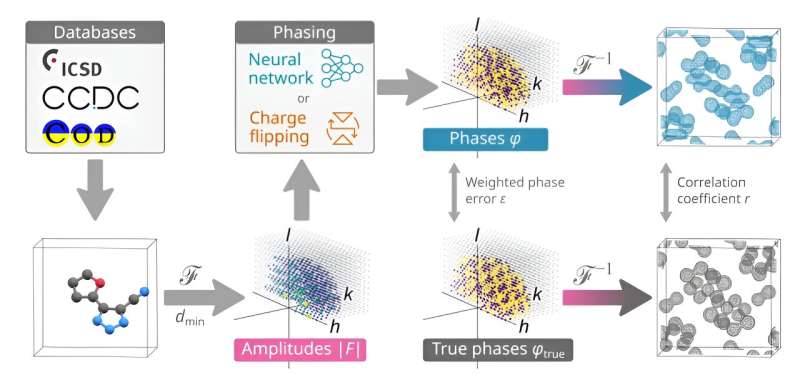
August 9, 2024 by Bob Yirka , Phys.org
Collected at: https://phys.org/news/2024-08-phai-ai-figures-phase-rays.html
A trio of chemists at the University of Copenhagen has developed an AI application that can be used to figure out the phase of x-rays that crystals have diffracted as part of efforts to predict the structure of small molecules.
In their paper published in the journal Science, Anders Larsen, Toms Rekis and Anders Madsen describe how they developed their system and how well it worked during testing.
Over the past several years, chemists and computer scientists have teamed up together to create AI applications that can be used to assist chemists in various applications. Such applications are a natural fit due to the way that a lot of chemistry is done—through trial and error.
As one example, an AI application was recently developed to predict protein structures. In this new effort, the researchers have used AI to create an application that can do the same for small molecules.
As the researchers note, the current process of predicting the structure of a given small molecule involves converting batches of them into solid crystals and then firing x-ray beams at them. The electrons in the x-ray beam bounce around after striking the crystal in a certain pattern—by analyzing the pattern, chemists can work out the structure of the molecules making up the crystal.
But there is a hitch: While it is relatively easy to measure the intensity of the x-rays during firing, researchers cannot measure their phase. Because of that, they must often guess, which often leads to what they describe as fuzzy diffraction patterns. In this new study, the research trio has found a way to use AI to find the uniqueness in patterns even if they are fuzzy.
To create their AI app, which they have called PhAI, the team used computer models to create millions of fake small molecule structures and to then compute the fuzzy diffraction patterns that would be produced due to their poor crystal structures.
They then used the results to train the AI on the relationship between the crystals and the fuzzy patterns that were produced. Doing so gave them both the phase and intensity information they needed, along with outputs for millions of possible molecules. They used that information to conduct final training.
Testing of the system showed it capable of accurately predicting the structure of 2,400 actual small molecules where the structure was already known. The research team plans to continue their work, hoping to expand the capabilities of PhAI beyond 50 atom molecules.
More information: Anders S. Larsen et al, PhAI: A deep-learning approach to solve the crystallographic phase problem, Science (2024). DOI: 10.1126/science.adn2777
Journal information: Science

Leave a Reply